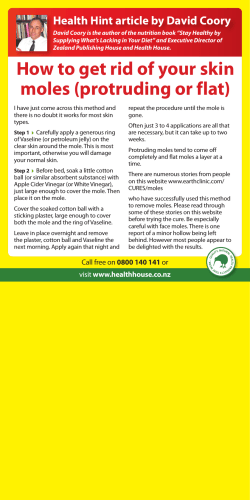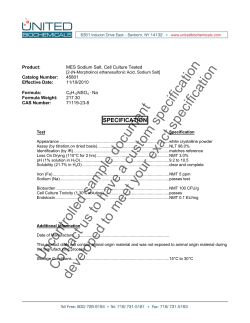
Holiday Homework Class-- XI Chemistry (2014-2015)
Holiday Homework Class-- XI Chemistry (2014-2015) 1) What is mole day? When is mole day? How do we celebrate mole day? In which countries mole day is being celebrated? 2) Collect information about group one elements( i.e. alkali metals) . Write about their abundance in the earth crust. Mention their applications in the field of medicine, industry and agriculture. 3) Do the following assignment in the assignment register Significant Figures and S.I. unit 1)What is the correct reading of a device with precision 1/100 of a unit? (i) 3.600g (ii) 3.60g (iii) 3.6g 2) State the no. of significant figures in each of the following: (i) 4.425g (ii) 5.6 X 103 cm (iii) 0.000124 m3 3) Write the following numbers in scientific notation (i) 4250000 (ii) 0.0008432 4) Express the following in SI units: (i) 90 miles per hour(The typical speed of Rajdhani Express) (ii) 5 feet 4 inches(The average height of Indian female) (iii) 140 pounds(The average weight of Indian male) (iv) 0.74 A0(The bond length of hydrogen molecule) Atomic and molecular mass , Mole concept 1) Are the atomic masses of the elements their actual masses? 2) 1.7 g of an unknown gas occupies 2.24 L at STP. Calculate its molecular mass and identify the gas. 3) Is the number of molecules in one mole of a gas at 1000C and 100 atm pressure equal to or less than the Avogadro’s no.? 4) Why is the value of Avogadro’s number 6.022 * 1023 and not any other value? 5) Are the atomic masses of some elements actually fractional? 6) If the atomic masses of C and S are 12 and 32 respectively, then atom of S is how many times heavier than an atom of carbon? Molecular Formula and Percentage composition 1) On analyzing an impure sample of sodium chloride, the percentage of chlorine was found to be 45.5. What is the percentage of pure sodium chloride in the sample? 2) Sodium is an important constituent of our body. Calculate the percentage of sodium in the breakfast cereal which has been advertised to contain 40 mg of sodium per 50 g of the cereal. 3) P and Q are the two elements which form P2 Q3 and PQ2 molecules. If 0.15 g mole of each weigh 15.9 g and 9.3 g respectively, what are the atomic masses of the elements P and Q? 4) The chemical compounds are represented by both Empirical and Molecular formula. Whereas the former if only theoretical , the latter is the actual formula of a compound. In some cases, the two may be even same. A very popular organic compound is a major constituent of alcoholic drinks. (i) What is the empirical formula of the compound? (ii) What is its molecular formula? (iii) Give the chemical name of the compound? (iv) Find the percentage composition of compound. 5) An organometallic compound on analysis gave the following results: c= 64.4%, H=5.5% , Fe= 29.9 %. Determine the empirical formula. Stoichiometry 1)What volume of hydrogen at S.T.P. would be liberated by the action of 50 ml of dilute H2 SO4 of 40 % purity and having a specific gravity of 1.3 g/ml on 65 g of zinc? (atomic mass of zinc= 65) 2) An impure sample of sodium chloride which weighed 1.2 gm gave on treatment with excess of silver nitrate solution gave 2.4 gm of silver chloride as the precipitate. Calculate the % purity of the sample. 3) Under similar conditions of temperature and pressure, 2 volumes of ozone(O3) on dec omposition give 3 volumes of oxygen (O2). 20 ml of the gaseous mixture when heated and then cooled expands to 21 ml. Find the percentage volume of ozone in the gaseous mixture. Concentration of solution 1) A solution of hydrochloric acid was titrated against a solution of sodium hydroxide of concentration 0.25 mol/ dm3. 25 cm3 of the acid solution neutralized 20.0 cm3 of alkali. Calculate (i) The no. of moles of alkali used in the titration. (ii) The no. of moles of acid used in the titration. (iii) The concentration of acid in moles/ dm3. 2) An antifreeze solution is prepared from 222.6 g of ethylene glycol(C2 H6 O2) and 200 g of water. Calculate the molality of the solution. If the density of the solution is 1.072 g/ml , then what shall be the molarity of the solution? 3) How many gm of concentrated nitric acid solution should be used to prepare 250 ml of 2.0 M HNO3 solution? The concentration of nitric acid is 70 % by mass. Value Based Questions 1)What is meant by the term “ Values” ? 2) How are the basic principles of science related to the values in our day- to- day life? 3) Very small particles of matter combine together to form many highly useful substances/materials. What lesson do you learn from this property of matter? 4) Many scientists before Mendeleev used atomic mass as the basis of classification of elements, but why did only Mendeleev succeed? 5) In most canteens, Ready to eat food packets with the following declarations are available. Packet 1 Contains Permitted Preservatives Packet 2 Packet 3 Contains permitted Contains both permitted Antioxidants antioxidants and preservatives i)Which packet would you prefer to buy? ii) Write the value associated with your choice. 6)A student was asked to verify the law of conservation of mass in the laboratory. He prepared 5% aqueous solution of NaCl and Na 2 SO4. He mixed 10 ml of both these solutions in a conical flask. He then weighed the flask on a balance. He then stirred the flask with a rod and weighed it after sometime. There was no change in mass. Read this narration and answer the following questions. (i) Was the student able to verify the law of conservation of mass? (ii) If not, what was the mistake committed by him? (iii)In your opinion, what he should have done? (iv) What is the value associated with it? 7)A student collected three samples of water from different sources and found out the percentage of hydrogen and oxygen by mass in these samples. It should have been 1:8 by mass. But it was different in all the three samples. Moreover, the values did not match. (i)In your opinion why did the student get different results for different samples? (ii) What should have been done by him? (iii) Which law of chemical combination is supported by these observations? (iv) How will you test the purity of water in the laboratory? 8) Ranjana refused to take home made ice-cream after two-three days. (i) Why did she refused to take ice-cream after two-three days? (ii) Mention the value associated with her decision. 9) Narrate two important incidents of your life where you have really made use of your scientific aptitude/approach to deal with the particular situation. Share your experience.
© Copyright 2025





















